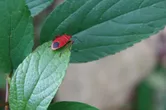Harmful Effects of Probergrothius nigricornis
A species of Probergrothius
Probergrothius nigricornis poses risks to plant health by extracting fluids from seeds and fruits, leading to underdevelopment and reduced reproductive success. The feeding process disrupts nutrient distribution, potentially causing premature fruit and seed drop or spoilage.
What Type of Pest Is Probergrothius nigricornis?









AI entomologist in your pocket
Scan QR code to download

